To test your perfume's longevity at home, you'll need five proven methods: Use paper strips to track scent projection over time, apply to pulse points after showering for skin testing, evaluate room dispersal patterns, check fabric retention on different clothing materials, and compare performance across multiple surfaces simultaneously. These techniques will help you assess sillage, staying power, and overall fragrance development. Discover which approach works best for your collection and wearing needs.
The Paper Strip Distance Test
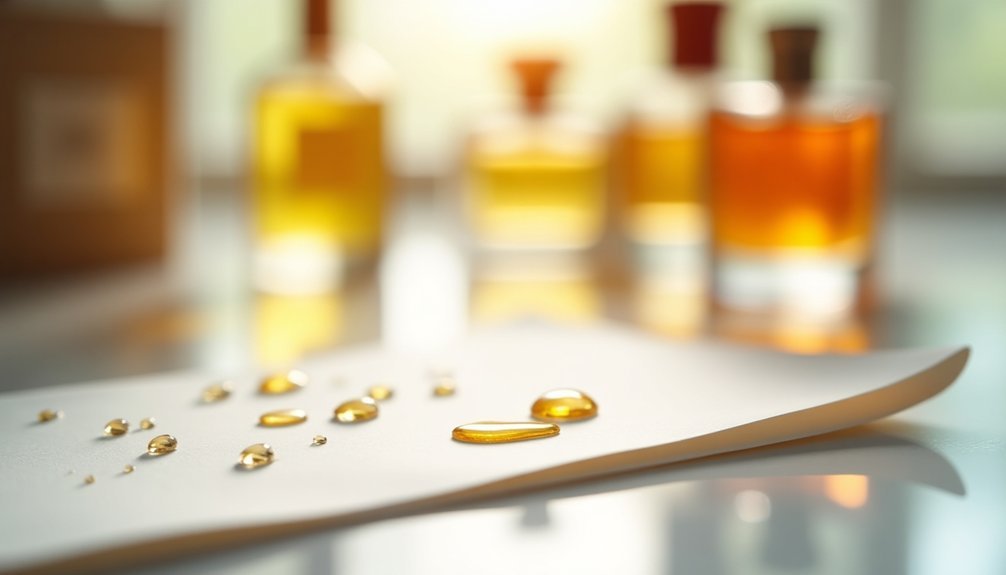
Anyone serious about evaluating fragrances should start with the Paper Strip Distance Test. This method gives you accurate insights into a perfume's longevity without the complications of skin chemistry.
The Paper Strip Distance Test offers the purest assessment of a fragrance's true character and lasting power, free from skin chemistry variables.
You'll need paper blotters to begin testing the scent profile of your chosen fragrance. Spray the fragrance on separate paper strips and let the alcohol evaporate before you start sniffing.
Keep the strips apart to prevent cross-contamination when you're comparing multiple scents. As time passes, test how far away you can detect the fragrance – this reveals its projection strength.
Unlike direct application, this technique prevents nose fatigue and gives you a clearer picture of the scent's true character. It's a reliable way to assess the longevity of a fragrance before committing to a purchase.
The Time-Based Skin Application Method
While paper strip testing offers valuable initial insights, testing perfume directly on your skin provides the most realistic assessment of its longevity.
The time-based skin application method begins right after your shower when your skin is most receptive. Apply the fragrance to your pulse points and start monitoring how long the perfume lasts.
To conduct an effective longevity assessment:
- Check for scent presence hourly, tracking changes as top notes fade and base notes emerge.
- Avoid reapplying during the test period (up to 12 hours or more).
- Combat nose fatigue by getting feedback from others about projection.
The Room Trail Assessment Technique
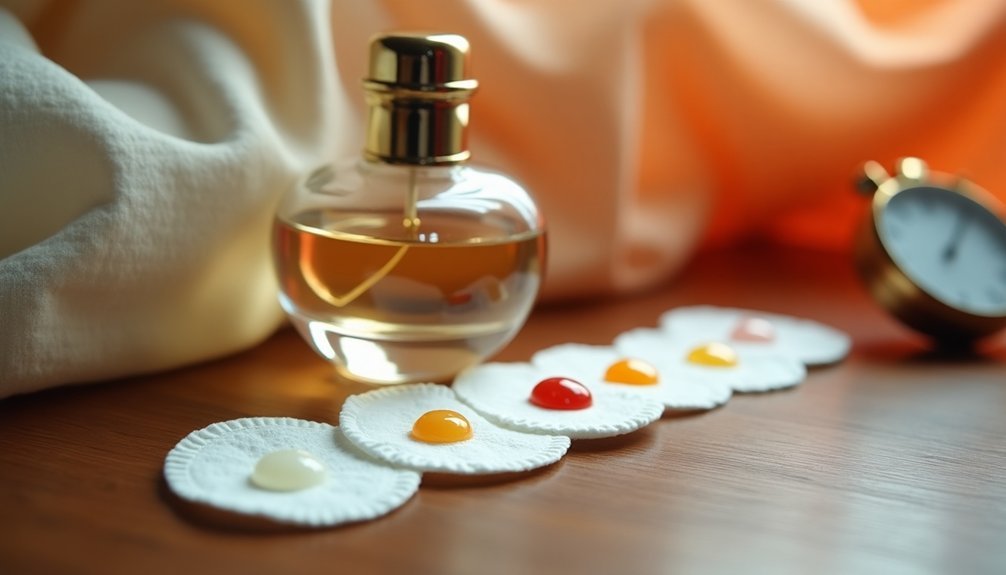
The Room Trail Assessment Technique offers three key advantages over traditional skin testing.
Discover more accurate fragrance evaluation with the Room Trail Assessment Technique, surpassing conventional skin tests in three distinct ways.
First, it lets you observe how the scent naturally disperses in a confined space, giving you a clear picture of its projection potential.
Second, you'll get an unbiased assessment of the fragrance's longevity without skin chemistry interference.
Third, you can track the evolution from top notes to base notes more objectively.
To conduct this assessment, spray the fragrance in a well-ventilated room.
Return at specific intervals – typically 1, 3, and 6 hours – to evaluate how the scent has developed.
Pay special attention to the long-lasting base notes, which emerge after the initial spray dissipates.
For the most thorough results, combine this method with skin testing to understand both the fragrance's room presence and personal wear characteristics.
The Clothing Fabric Persistence Check
Since clothing often retains fragrances longer than skin, conducting a fabric persistence check provides valuable insights into a perfume's true lasting power.
To assess scent longevity accurately, you'll need to gather various fabric types to test their absorbency with your chosen fragrance.
Here's how to conduct a thorough fabric persistence test:
- Cut small swatches of different materials (cotton, silk, synthetics) and label them clearly for testing.
- Spray each fabric from a consistent distance (about 6 inches) using the same amount of fragrance.
- Check and document the scent's strength at regular intervals over several days.
Don't wash the test swatches during your evaluation period, as this will interfere with accurate results.
This testing method helps you understand how your perfume performs across different fabric types and reveals its true persistence potential.
The Multi-Surface Performance Analysis
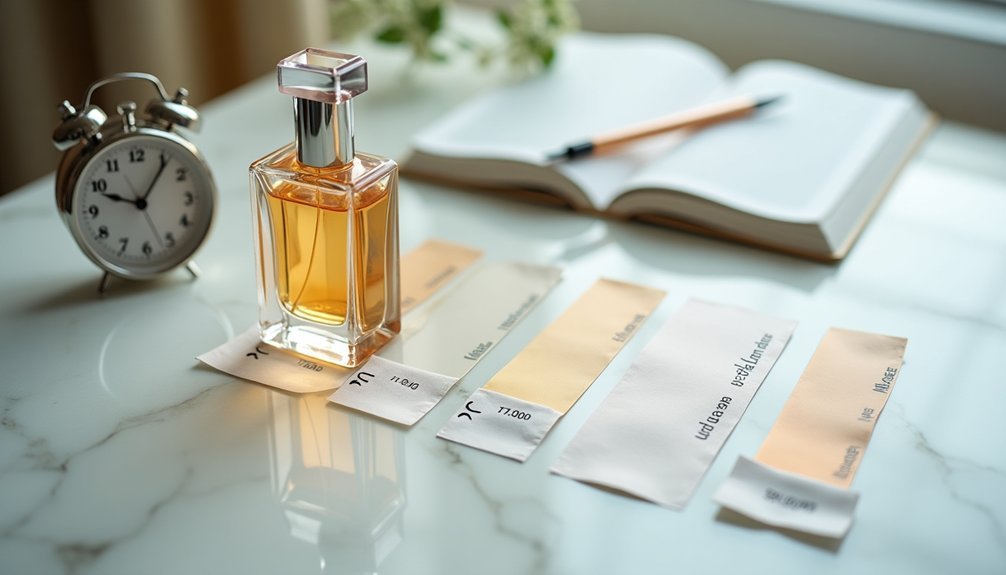
Understanding how your perfume performs across multiple surfaces provides the most extensive assessment of its longevity potential.
You'll want to test your fragrance on your skin, clothing, and paper blotters simultaneously to compare how each surface affects the scent's projection and staying power.
Your skin chemistry plays an essential role in how the perfume develops, so don't rely solely on clothing tests.
Testing perfume on skin is crucial since your unique body chemistry directly influences how the fragrance evolves and performs.
Try applying the fragrance to different fabric types, as some materials will hold the scent longer than others.
Pay attention to how the performance varies between surfaces throughout the day.
This thorough analysis will help you determine whether your fragrance works better directly on skin or if it's more effective when layered on fabrics.
You'll also discover its overall versatility for different wearing situations.
Frequently Asked Questions
How Do You Test Perfume Longevity?
You'll want to apply perfume to your pulse points after showering, let it settle, and track how many hours the scent lasts. Use your wrist or hand, and don't forget to note its presence on clothing.
How Can I Test My Perfume at Home?
Spray your perfume on pulse points after showering, then track how it develops over time. You'll want to check every few hours, use blotter strips, and get feedback from others to assess performance.
How Do I Know if My Perfume Is Long Lasting?
You'll know your perfume is long-lasting if you can still smell it after 12+ hours on your skin. Spray it on pulse points post-shower and check periodically. Ask others if they notice the scent too.
How to Test the Sillage of a Perfume?
Apply your perfume to pulse points and ask a friend to note how far they can smell it. You'll know your fragrance's sillage by tracking its trail in spaces and getting feedback from others.
In Summary
Testing your perfume's longevity doesn't have to be complicated. You'll get reliable results using these five home methods, from the simple paper strip test to the thorough multi-surface analysis. Whether you're evaluating a new fragrance or comparing different scents, these techniques will help you determine which perfumes truly last. Now you can make informed decisions about your fragrance purchases based on real performance data.
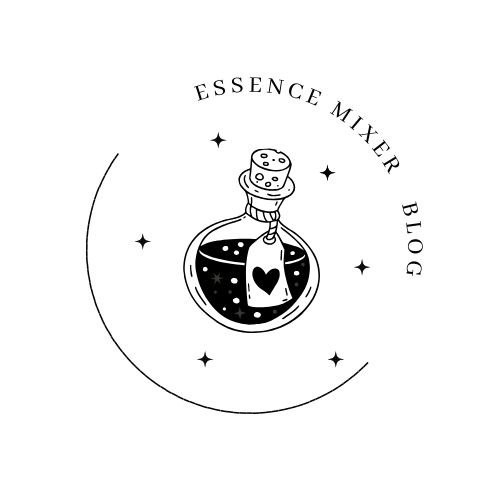
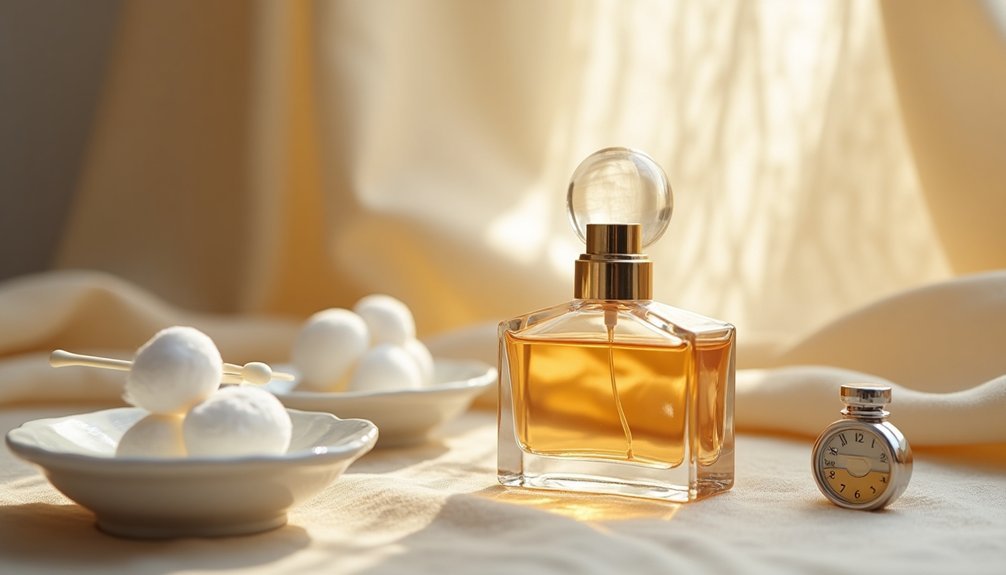



Leave a Reply